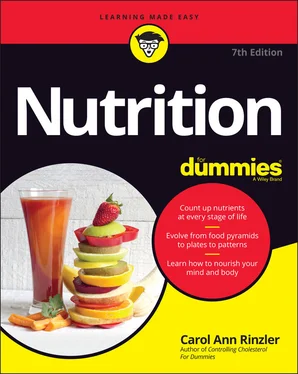1 ...7 8 9 11 12 13 ...18 Confused? Not to worry. This chapter spells it all out.
RDAs: Guidelines for Good Nutrition
The Recommended Dietary Allowances (RDAs) were created in 1941 by the Food and Nutrition Board, a subsidiary of the National Research Council, which is part of the National Academy of Sciences in Washington, D.C., in order to investigate issues of nutrition that might “affect national defense.” The committee was renamed the Food and Nutrition Board in 1941, after which they began to deliberate on a set of recommendations of a standard daily allowance for each type of nutrient. The standards would be used for nutrition recommendations for the armed forces, for civilians, and for overseas populations who might need food relief.
RDAs originally were designed to make planning several days’ meals in advance easy for you. The D in RDA stands for dietary, not daily, because the RDAs are an average. You may get more of a nutrient one day and less the next, but the idea is to hit an average over several days.
For example, the current RDA for vitamin C is 75 milligrams for a woman and 90 milligrams for a man (age 18 and older). One 8-ounce glass of fresh orange juice has 120 milligrams of vitamin C, so a woman can have an 8-ounce glass of orange juice on Monday and Tuesday, skip Wednesday, and still meet the RDA for the three days. A man may have to toss in something else — maybe a stalk of broccoli — to be able to do the same thing. No big deal.
The amounts recommended by the RDAs provide a margin of safety for healthy people, but they’re not therapeutic. In other words, RDA servings won’t cure a nutrient deficiency, but they can prevent one from occurring.
Proteins, vitamins, and minerals: The essentials
RDAs offer recommendations for protein and 18 essential vitamins and minerals. For the specific amounts, check out Chapter 6(protein), Chapter 10(vitamins), and Chapter 11(minerals).
Recommendations for carbohydrates, fats, dietary fiber, and alcohol
What nutrients are missing from the RDA list of essentials? Carbohydrates, fiber, fat, and alcohol. The reason is simple: If your diet provides enough protein, vitamins, and minerals, it’s almost certain to provide enough carbohydrates and probably more than enough fat. Although no specific RDAs exist for carbohydrates and fat, guidelines definitely exist for them and for dietary fiber and alcohol.
In 1980, the U.S. Public Health Service and the U.S. Department of Agriculture joined forces to produce the first edition of Dietary Guidelines for Americans (see Chapter 16). A new edition of the Dietary Guidelines has been issued every five years since then to set parameters for what you can consider reasonable amounts of calories, carbohydrates, dietary fiber, fats, protein, and alcohol. According to these guidelines, several general rules advise you to
Balance your calorie intake with energy output in the form of regular exercise. Check out Chapter 5for specifics on how many calories a person of your weight, height, and level of activity (couch potato? marathon runner?) needs to consume each day.
Make foods with complex carbohydrates and dietary fiber (defined in Chapter 8 ) the base of your total daily calories. These should make up to 900 to 1,300 calories and up to 25 grams dietary fiber on a 2,000 calorie per day diet.
Concentrate on unsaturated fats. For more specific guidelines, check out Chapters 16and 17and Chapter 7for everything you need to know about the individual dietary fats.
Drink alcohol only in moderation. That means one drink a day for a woman and two for a man. As the Guidelines note, neither is a component of the USDA Dietary Patterns.
Different people, different needs
Because different bodies require different amounts of nutrients, RDAs currently address as many as 22 specific categories of human beings: boys and girls, men and women, from infancy through middle age. In 2006, the RDAs were expanded to include recommendations for groups of people age 50 to 70 and 71 and older.
 These expanded groupings are a really good idea. In 1990, the U.S. Census counted 31.1 million Americans older than 65. By 2050, the U.S. government expects more than 60 million mostly active older citizens.
These expanded groupings are a really good idea. In 1990, the U.S. Census counted 31.1 million Americans older than 65. By 2050, the U.S. government expects more than 60 million mostly active older citizens.
If age is important, so is gender. For example, because women of child-bearing age lose iron when they menstruate, their RDA for iron is higher than the RDA for men. On the other hand, because men who are sexually active lose zinc through their ejaculations, the zinc RDA for men is higher than the zinc RDA for women.
 And gender affects body composition, which influences other RDAs, such as protein: The RDA for protein is set in terms of grams of protein per kilogram (2.2 pounds) of body weight. Because the average man weighs more than the average woman, his RDA for protein is higher than hers. The RDA for an adult male, age 19 or older, is 56 grams; for a woman, it’s 46 grams.
And gender affects body composition, which influences other RDAs, such as protein: The RDA for protein is set in terms of grams of protein per kilogram (2.2 pounds) of body weight. Because the average man weighs more than the average woman, his RDA for protein is higher than hers. The RDA for an adult male, age 19 or older, is 56 grams; for a woman, it’s 46 grams.
SEVEN RULES FOR LADIES-IN-WAITING
The 2020 edition of the Dietary Guidelines for Americans is the first one in which the scientific advisory committees chose to focus on how what a pregnant woman eats affects the health of her developing baby. Here’s their advice based on what they found:
1 Women of child-bearing age should be encouraged to achieve and maintain a healthy weight before becoming pregnant and during pregnancy itself. (For more on healthful weight, check out Chapter 4.)
2 When picking a dietary pattern, aim for one rich in fruits and veggies, whole grains, seafood, and vegetable oils while cutting back on added sugars, refined grains, and red and processed meats. (More on that in Chapter 17.)
3 Choose plant foods that are good sources of important vitamins such as folate and minerals such as calcium.
4 Don’t worry about allergens unless it’s the mother’s allergy. What a pregnant woman eats does not appear to create allergies in the baby.
5 Include at least 8 ounces and as much as 12 ounces of seafood once a week. Aim for seafood low in mercury and high in protective omega-3 fatty acids.
6 No alcohol. Period.
7 Stay away from chancy, possibly contaminated foods such as unpasteurized milk and undercooked meats.
AIs: The Nutritional Numbers Formerly Known as ESADDIs
In addition to the RDAs, the Food and Nutrition Board has created an Adequate Intake (AI) for eight nutrients considered necessary for good health, even though nobody really knows exactly how much your body needs. Not to worry: Sooner or later, some smart nutrition researcher will come up with a hard number and move the nutrient to the RDA list.
You can find the AIs for biotin, choline, and pantothenic acid in Chapter 10, along with the requirements for other vitamins. The AIs for the minerals calcium, chromium, molybdenum, and manganese are in Chapter 11with the other dietary minerals.
DRI: The Totally Complete Nutrition Guide
In 1993, the Food and Nutrition Board’s Dietary Reference Intakes committee set up several panels of experts to review the RDAs and other recommendations for major nutrients (vitamins, minerals, and other food components) in light of new research and nutrition information. The first order of business was to establish a new standard for nutrient recommendations called the Dietary Reference Intake (DRI). DRI is an umbrella term that embraces several categories of nutritional measurements for vitamins, minerals, and other nutrients. It includes
Читать дальше

 These expanded groupings are a really good idea. In 1990, the U.S. Census counted 31.1 million Americans older than 65. By 2050, the U.S. government expects more than 60 million mostly active older citizens.
These expanded groupings are a really good idea. In 1990, the U.S. Census counted 31.1 million Americans older than 65. By 2050, the U.S. government expects more than 60 million mostly active older citizens.










